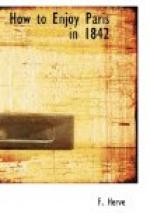by being asked for the keys of his trunks, for the
Custom House officers, to make believe to look into
them to ascertain that you have not smuggled any liquors
or other material within the walls of Paris. Those
who are fortunate enough to travel in their own carriages,
are exempted from such tiresome ceremony. Some
of the other entries to Paris are somewhat better,
but none of them sufficiently so, to be worthy notice;
perhaps the best amongst the bad is by the Faubourg
St. Antoine, the Barrieres du Trone, at the commencement
and summit of the street, presenting a most noble
appearance; indeed, as far as the barriers are concerned,
there are many which are well worthy of notice, being
mostly handsome stone buildings with columns that
give them an imposing effect, particularly when we
recollect the little turnpike gates at the principal
entrances of London, with the exception of the recent
erections at Knightsbridge, which sink into nothingness
when compared to the Triumphal Arch at the entrance
already described; and, except foreigners, particularly
the English, enter by that quarter, the first aspect
of Paris mostly excites disappointment; the generality
of the streets wanting that straight line of regularity
so prevalent throughout London, the French capital
has an incongruous patchy sort of effect, and its beauties
and objects of interest have to be sought, but to
the eye of an artist it is much more gratifying than
that dull sameness which reigns throughout London,
which Canova very justly designated as consisting of
walls with square holes in them; for what otherwise
can be said of our houses in general, but that they
are literally upright walls, with square holes for
doors and windows. Regent Street and a few others,
which have been recently erected, form an exception
to the rule. But in almost every street in Paris
a draftsman finds subject for his pencil; their richly
carved gateways, their elaborately wrought iron balconies,
their ornamented windows, and even their protruding
signs, all help to break the formal straight line
and afford ample food for sketching; and in many of
their old and least fashionable streets, an ancient
church with its gothic doorway, adorned by rich and
crumbling sculpture, invites the artist to pause and
exercise his imitative art. Paris at first strikes
a stranger as still more bustling and noisy than London,
as the streets being narrower and hack vehicles more
used in proportion, the circulation gets sooner choked
up, and the rattling over the stones of the carriages
is still more deafening, being within so confined a
space; hence also the confusion is greater; then there
is always a sort of bewilderment when one first arrives
in a large city, that makes it appear much more astounding
than is found to be the case as soon as the visiter
becomes accustomed to its apparent labyrinth.




